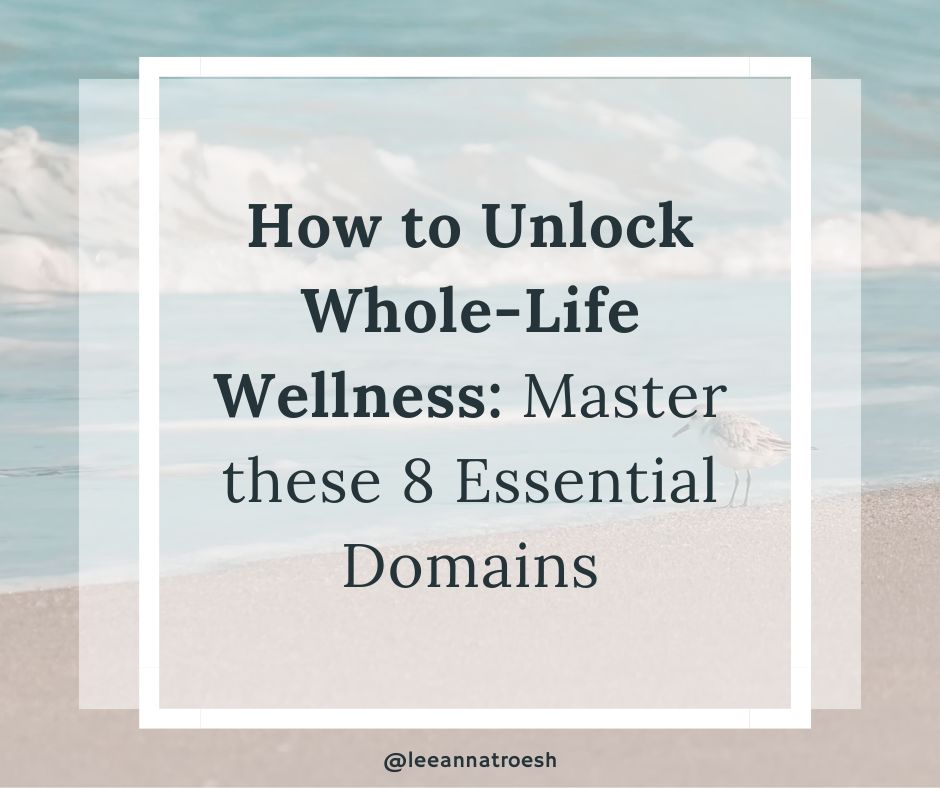In Western culture, we celebrate independence, individualism, and capitalism. Being an entrepreneur, creative, and innovative is highly valued. However, the work-life balance trend of the 1980s has left many of us striving for something that often feels unattainable. Despite working hard, getting married, having a family, socializing with friends, and upholding good morals, it seems never enough.
We label people by the choices they make and the paths they take. If we decide to take time for ourselves and not for our family or children, we are “selfish.” It’s time to shift our perspective and focus on well-researched personal development strategies for whole-life wellness that can leave us feeling fulfilled rather than depleted and exhausted.
The following introduces strategies for enhancing the eight domains of wellness outlined by the Substance Abuse and Mental Health Service Administration (SAMHSA). You can achieve a balanced and satisfying life by understanding these domains and implementing practical tools.
The Eight Domains of Wellness, outlined by the Substance Abuse and Mental Health Services Administration (SAMHSA, 2021), are a comprehensive framework for achieving whole-life wellness.
These 8 Domains of Wellness Are:
1. Emotional Wellness
Emotional wellness involves understanding your feelings and coping effectively with stress. Strategies for improvement include:
- Mindfulness and Meditation: Practice mindfulness or meditation to manage stress and increase emotional resilience.
- Journaling: Regularly write down your thoughts and feelings for better insight and clarity.
- Therapy and Counseling: Seek professional help to work through emotional challenges.
2. Environmental Wellness
Environmental wellness involves living in a healthy, safe environment that supports well-being. Strategies include:
- Decluttering: Regularly declutter your living and working spaces to create a more peaceful environment.
- Sustainability: Adopt sustainable practices like recycling and using eco-friendly products.
- Nature Exposure: Spend time in nature to reduce stress and enhance mood.
3. Financial Wellness
Financial wellness involves managing your finances to reduce stress and enhance your quality of life. Strategies include:
- Budgeting: Create a budget to track your income and expenses.
- Saving: Set up a savings plan for emergencies and future goals.
- Financial Education: Educate yourself about financial planning and investments.
4. Intellectual Wellness
Intellectual wellness involves engaging in activities stimulate your mind and enhance your knowledge. Strategies include:
- Lifelong Learning: Take up new courses or hobbies to continually challenge yourself.
- Reading: Regularly read books, articles, or journals that interest you.
- Puzzles and Games: Engage in puzzles, games, or activities that challenge your brain.
5. Occupational Wellness
Occupational wellness involves finding fulfillment and balance in your work. Strategies include:
- Career Planning: Set career goals and create a plan to achieve them.
- Work-Life Balance: Strive for a healthy balance between work and personal life.
- Job Satisfaction: Seek work that aligns with your values and interests.
6. Physical Wellness
Physical wellness involves taking care of your body through exercise, nutrition, and healthy habits. Strategies include:
- Regular Exercise: Incorporate physical activity into your daily routine.
- Healthy Eating: Follow a balanced diet rich in nutrients.
- Regular Check-ups: Schedule regular health check-ups and screenings.
7. Social Wellness
Social wellness involves building healthy, nurturing, and supportive relationships. Strategies include:
- Quality Time: Spend quality time with friends and family.
- Community Involvement: Participate in community activities or volunteer work.
- Healthy Boundaries: Establish and maintain healthy boundaries in relationships.
8. Spiritual Wellness
Spiritual wellness involves seeking meaning and purpose in life. Strategies include:
- Meditation and Prayer: Engage in practices that help you connect with your spiritual beliefs.
- Reflection: Take time for self-reflection and contemplation.
- Community: Join spiritual or religious communities for support and connection.
Implementing the Wellness Strategies
To effectively strengthen your protective factors, which are the aspects of your life that contribute to your overall well-being, and enhance these eight dimensions of wellness, consider the following steps:
- Self-Assessment: Take the reins of your wellness journey by evaluating where you currently stand in each of the eight dimensions. This self-assessment will empower you to identify areas for improvement and take steps towards a balanced life.
- Set Goals: Based on your assessment, set specific, measurable goals for improvement in each dimension. These goals will serve as your roadmap, keeping you motivated and focused on your journey to wellness.
- Create a Plan: To achieve your wellness goals, it’s essential to have a plan. Develop a plan incorporating the strategies discussed, and you’ll feel more organized and prepared for your journey to whole-life wellness.
- Commit to Action: Dedicate time and effort to implement your plan. Consistency is critical to achieving wellness.
- Monitor Progress: Regularly review your progress and adjust your plan as needed. Celebrate your successes, such as treating yourself to a spa day after consistently maintaining a healthy diet or taking a weekend trip after achieving a financial goal. These celebrations can provide a sense of achievement and motivation.
Conclusion
Strengthening protective factors by enhancing the eight domains of wellness is a holistic approach to achieving whole-life wellness. By implementing the strategies discussed in this post, you can create a balanced, fulfilling life that supports your overall well-being. Remember, wellness is a journey, not a destination. Embrace the process, and you’ll live a more enriched and satisfying life.
1- (2021). Substance Abuse And Mental Health Services Administration (SAMHSA) Indefinite Quantity Indefinite Delivery (idiq).


